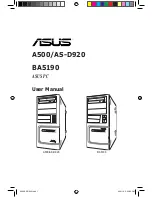
76
Chapter 4
Power-On Self-Test (POST)
Each time you turn on the system, the Power-on Self Test (POST) is initiated. Several items are tested during
POST, but is for the most part transparent to the user.
The Power-On Self Test (POST) is a BIOS procedure that boots the system, initializes and diagnoses the
system components, and controls the operation of the power-on password option. If POST discovers errors in
system operations at power-on, it displays error messages on screen, generates a check point code at port
80h or even halts the system if the error is fatal.
The main components on the main board that must be diagnosed and/or initialized by POST to ensure system
functionality are as follows:
T
Microprocessor with built-in numeric co-processor and cache memory subsystem
T
Direct Memory Access (DMA) controller
T
Interrupt system
T
Three programmable timers
T
ROM subsystem
T
RAM subsystem
T
CMOS RAM subsystem and real time clock/calendar with battery backup
T
Onboard parallel interface controller
T
Embedded hard disk interface and one diskette drive interface
T
Keyboard and auxiliary device controllers
T
1.44M floppy controller
T
I/O ports
T
One parallel port
T
One PS/2-compatible mouse port
T
One PS/2-compatible keyboard port
NOTE:
When Post executes a task, it uses a series of preset numbers called check points to be latched at
port 80h, indicating the stages it is currently running. This latch can be read and shown on a debug board.
The following table describes the BIOS common tasks carried out by POST. Each task is denoted by an
unique check point number. For other unique check point numbers that are not listed in the table, refer to the
corresponding product service guide.
Post Checkpoints List: The list may vary accordingly depending on your BIOS
.
Checkpoint
Description
CFh
Test CMOS R/W functionality
C0h
Early chipset initialization:
-Disable shadow RAM
-Disable L2 cache (socket 7 or below)
-Program basic chipset registers
C1h
Detect memory
-Auto-detection of DRAM size, type and ECC.
-Auto-detection of L2 cache (socket 7 or below)
C3h
Expand compressed BIOS code to DRAM
C5h
Call chipset hook to copy BIOS back to E000 & F000 shadow RAM.
01h
Expand the Xgroup codes locating in physical address 1000:0
02h
Reserved
03h
Initial Superio_Early _Init switch
Summary of Contents for Veriton 3700G
Page 12: ...6 Chapter 1 Rear Panel for Veriton 3700G ...
Page 34: ...Chapter 2 28 ...
Page 59: ...53 Chapter 2 ...
Page 62: ...Chapter 3 50 VT 3700G Disassembly Flow Chart ...
Page 70: ...Chapter 3 58 12 Pull out the reset cable carefully ...
Page 71: ...59 VT 5700G Disassembly Flow Chart ...
Page 78: ...66 9 Remove the daughter board from the daughter board bracket ...
Page 79: ...67 VT 7700G Disassembly Flow Chart ...
Page 108: ...93 Chapter 6 Veriton 7700G Exploded Diagram ˌ ˆ ˇ ˈ ʳ ʳ ʳˆʳ ʳˇ ʳˈ ʳˉ ʳˊ ʳˋ ʳˌ ˆ ˇ ˈ ˉ ˊ ˋ ...
Page 109: ...Chapter 6 94 Veriton 5700G Exploded Diagram ʳ ʳ ʳˆ ʳˇ ʳˈ ʳˉ ʳˊ ʳˋ ʳˌ ˆ ˇ ˈ ˉ ˊ ˋ ˌ ˆ ...
Page 110: ...95 Chapter 6 Veriton 3700G Exploded Diagram ˉ ʳ ˈ ˇ ˆ ʳ ʳˆ ʳˇ ʳˈ ʳˉ ʳˊ ʳˋ ʳˌ ˆ ˇ ˈ ˉ ˊ ˋ ˌ ...















































